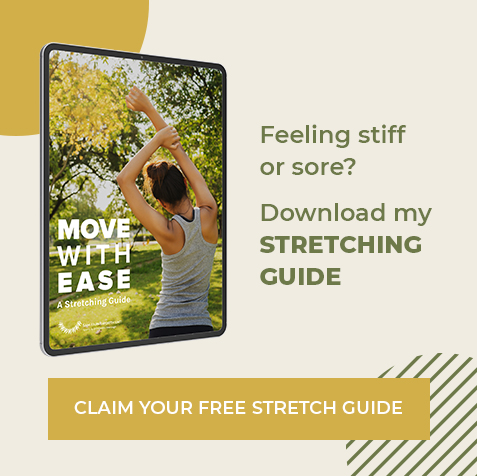Do you work at a computer all day? Or are you on your feet all day working with your hands? I bet some days your back is on fire! Especially right between the shoulder blades… or your neck hurts to nod or look up!

YOU can do these stretches at home and get some immediate relief.

All those muscles along the side of your spine, from your waist up to the base of your skull are working hard to keep you upright. But they are working even harder if you are looking down, or craning your neck forward. This has gotten even more pervasive during the Covid-19 crisis, as people are working at their computers on “home-made work stations”. At least half of the patients I have seen in the last two months have neck issues.
The stretches that follow are “active” stretches: movement through the muscle produces initial contraction, then release, which produces greater comfort.

The neck muscle at work here is the levator scapulae (pictured on the right). This muscle is symptomatic if you feel it through the side/back of your neck down into the top of your shoulder. The neck stretch works with the nervous system. When you momentarily engage a muscle and then relax, the muscle will stretch farther than it could initially. This is called proprioceptive neuromuscular facilitation.

The back muscles that run along your spine from pelvis to skull are collectively called the erectors (picture on the left). These are muscles that get tight along the spine, from the middle of the back to the waist. The back stretch works with a “pin and shorten” technique. You lie on two balls, moving them up vertebrae by vertebrae. At each vertebrae you pause and perform movement with your arms. The ball “pins” the muscles, while the arm movement engages the back muscles – shortening them. Pin and shorten is a classic massage technique. If you’ve ever had me work on your calves or forearms and move your feet or hands while I’m doing that, we are doing a pin and shorten.
Stretches
The videos below provide details on these stretches. For the back muscles (erectors), you will need two tennis or lacrosse balls and a sock.
Neck
Back
Perform 8-10 repetitions of the neck stretch1. You may want to do these stretching clusters 2-3 times/day until it starts to feel better (particularly after you get up from a long episode at the computer). Do not apply a lot of force when stretching the neck.
I perform 2 passes while on my back. Doesn’t matter which way you go. The back stretch2 is a great stretch to do a couple times a week, whether you feel discomfort or not. I am often surprised to find one side tighter than the other when I do this.. but it always feels great.
Think About the Source of Discomfort
Here are some things to think about that may be sources of discomfort:
- Do you sleep on your stomach? This is a common source of neck discomfort.
- Do your best to modify sleep position: sleeping on your back is ideal.
- Workstation tips:
- Arms should be parallel to the floor while on keyboard.
- Screen should be level with your eyes (what old text books are for).
- Or if you are working with your hands – try to set up your workplace so you aren’t leaning forward (like I do at my kitchen counter).
- Work should be at (no more than) arms length when you are standing up straight.
- Try elevating your work space if needed (work on a box or something similar).
- For cell phone
- Try not to hold it at your waist. Maybe put your elbows on counters and hold the screen up higher.
If you have any questions or want to discuss these concepts further, please call or email me.
Live with Ease.
Sam Farnsworth LMT, CPT
Sports & Orthopedic Massage
Samfarnsworth12@gmail.com
978 467 5371
@samfarnsworthlmt
References:
1 – Mattis, Aaron, Active Isolated Stretching: The Mattis Method, published by Aaron Mattis, 2000, p.41
2 – Dicharry, Jay, Running Rewired, Velopress, 2017, P.44
Figures are generated from Essential Anatomy 5, 3D4Medical by Elsevier

